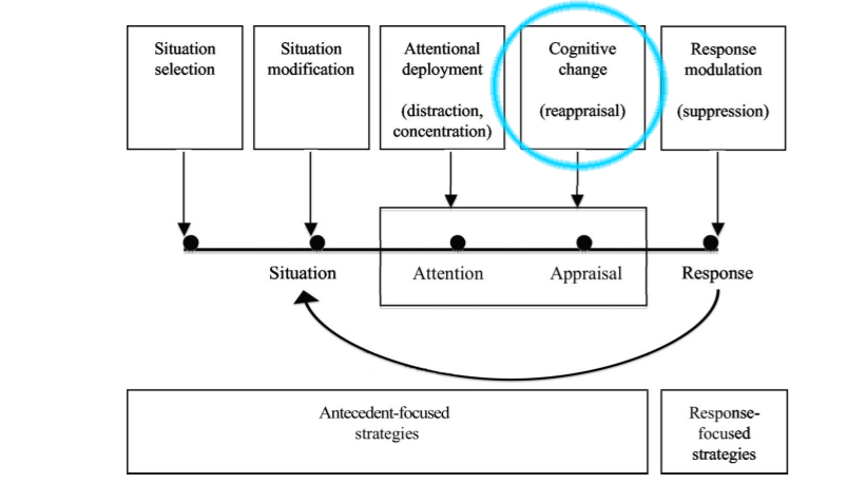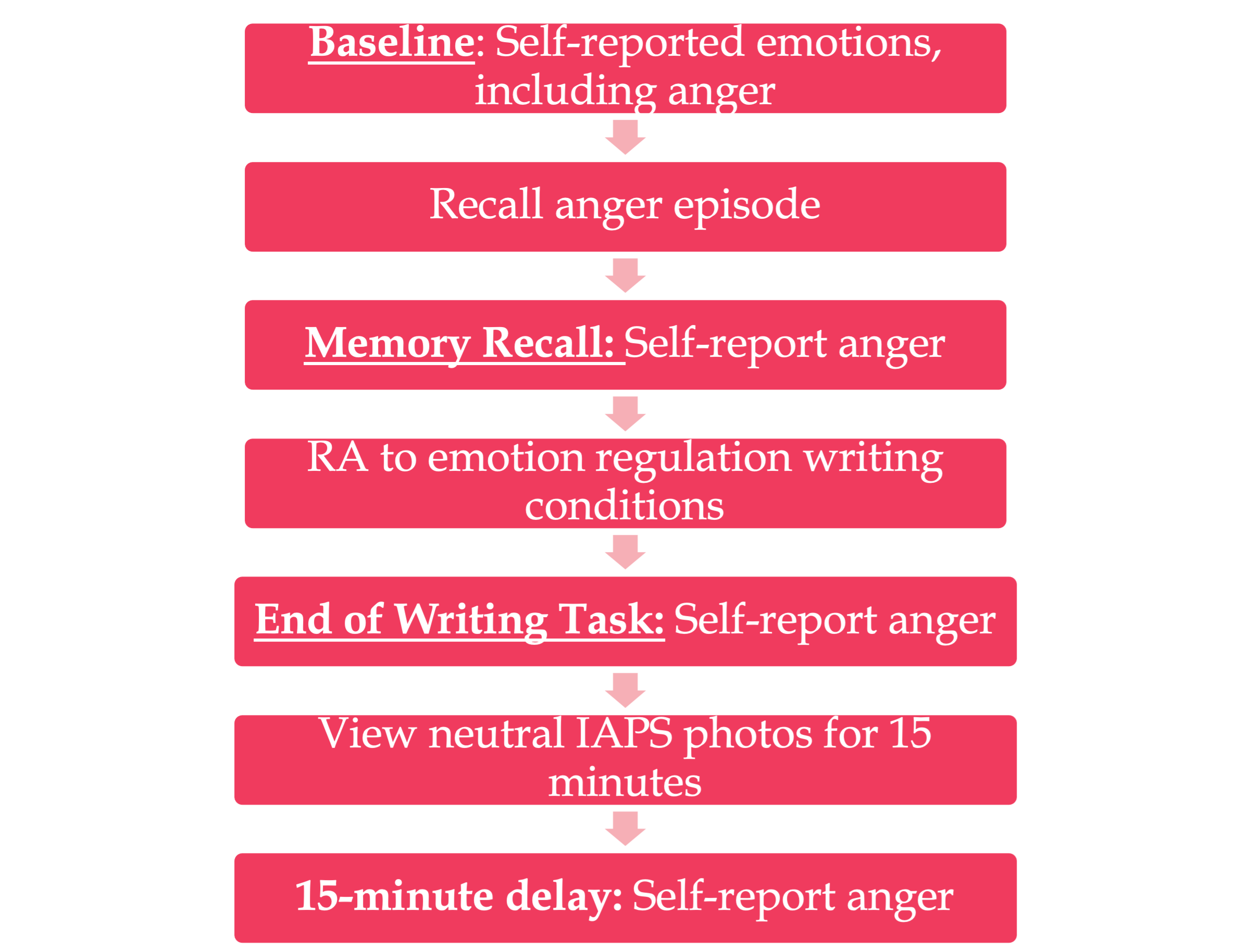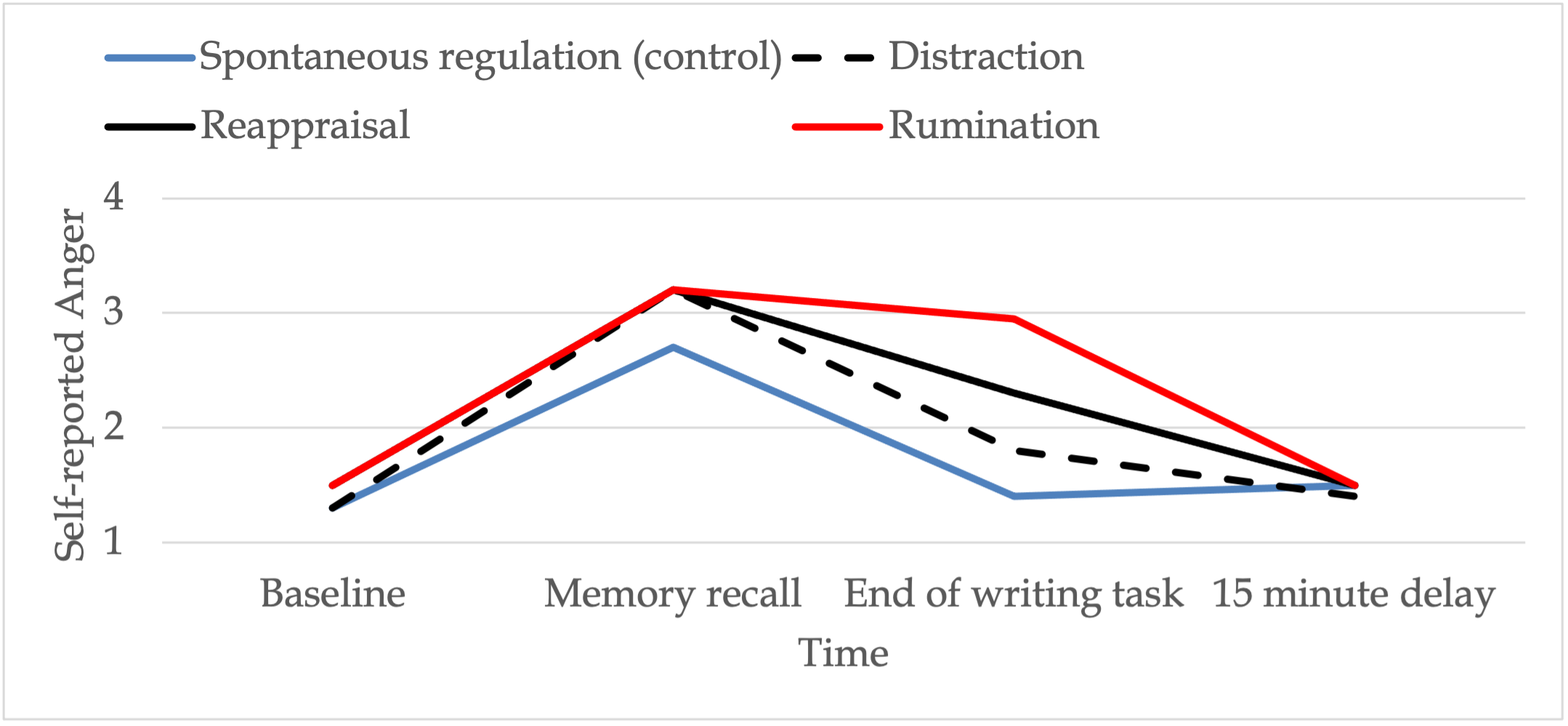Chapter 14 – Emotion Regulation
Cognitive Change

Cognitive changes occurs when we select which of several potential emotional meanings will be attached to a situation. Then, later this meaning gives rise to subjective feelings, and behavioral and physiological changes. Cognitive change occurs when we alter our cognitive appraisals and changing these cognitive appraisals changes our emotional experiences.
According to Webb et al. (2012), several types of cognitive change exist:
- reappraising the emotional stimulus: interpreting the emotional event in a more positive way.
- reappraisal using perspective-taking: participants interpret the emotional event from a new perspective. This new perspective could be as a neutral observer or from the viewpoint of another individual.
- reappraising the emotional response: sometimes called accepting the emotions. When reappraising the emotional response, people might interpret their feelings and try to accept their emotions instead of judging them (remember we talked how accepting negative emotions might cause happiness!).
- a combination of the prior 3 cognitive change strategies.
Gross (1998) agrees that reappraisal is a type of cognitive change. He further identifies other types of cognitive change discussed below. Take note that many of these cognitive change strategies are derived from Sigmund and Anna Freud’s work on defense mechanisms.
- Denial occurs when we do not accept the occurrence of the eliciting event. Typically, denial occurs when people do not acknowledge a negative event that has occurred.
- Intellectualization occurs when we think about the rational, non-emotional parts of the eliciting event. During intellectualization, people are not thinking about or appraising their emotion responses to the eliciting event.
- Downward social comparison occurs when we compare our situation to someone worse off, causing us to interpret our situation as more positive than before the comparison. Downward social comparison also increases our self-esteem (positive feelings toward the self) and reduces our negative emotions.
Let’s look at a study that compares the effects of several cognitive change regulation strategies. In one study (Denson et al., 2012) participants first completed baseline emotion measures. Then, participants recalled a time they felt anger toward another person within the last year and wrote down details of the event. Then, participants were randomly assigned to engage in spontaneous regulation (control), rumination, reappraisal, or distraction for 20 minutes. In the control condition, participants were told to write about their thoughts, but were not given and instructions about regulating their emotions. Below are the instructions each group received (Denson et al., 2012, p. 357-358):
Rumination: “I want you to write about it in a way that brings to mind the causes and consequences of the event. Try to think about the reasons for and the causes of the event, what it means that it happened the way it did, and the future implications of the event. Try to think about why people acted the way they did and what the event means to you.”
Reappraisal: “I want you to think about it in a different, more objective and positive way. Try to think about some positive aspects of the event, such as lessons you have learned, and ways that you could improve in the future if the same event were to arise. Also, try to think about factual, nonemotional details, such as where and when the event occurred.”
Distraction: “Please describe the layout of the UNSW campus as you see it in your mind and how you would describe it to someone who has never been here before. Please write a thorough and detailed description.”
Spontaneous Regulation: “I would like you to write about whatever is on your mind in this moment. It can be anything at all. Please describe all the things that you are thinking about, as well as the way in which you are thinking about them.”
Anger was measured at four different time points (see Figure 9 below).
Figure 9
Procedures from Denson et al. (2012)

See Figure 10 for the findings. Participants who ruminated did not show a change in their anger levels, but those in the other conditions reported their anger decreased from the time they recalled the anger episode to after they engaged in the regulation writing strategy. Interestingly, people who ruminated and reappraised had more anger emotion words in their writing compared to the other conditions. Participants who ruminated used more negative emotion words than all other conditions, whereas participants who reappraised used more positive emotion words versus other conditions. Finally, ruminating caused more past tense verbs and rumination more future tense verbs. This finding shows that when we ruminate, we focus on our past feelings and thoughts, whereas reappraisal causes people to think about the future and how to solve the eliciting event. Taken together, these findings suggest that reappraisal includes thoughts about negative emotions that are later transferred into positive emotions. It may be that people turn their negative emotions into positive ones when they think about the future, instead of focusing on the past event. Rumination causes more negative emotions because participants are thinking about the emotions and thoughts of the past event, instead of focusing on ways to overcome the problem in the future.
Figure 10
Self-Reported Anger Over Time for Four Emotion Regulation Groups

Adapted from “The Effects of Analytical Rumination, Reappraisal, and Distraction on Anger Experience, ” by T.F. Denson, M.L. Moulds, and J.R. Grisham, 2012, Behavior Therapy, 43(2), p. 360 (https://doi.org/10.1016/j.beth.2011.08.001). Copyright 2011 Association for Behavioral and Cognitive Therapies.

